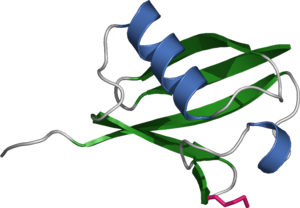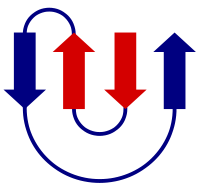Beta sheet
The beta sheet, β-folded sheet (β-sheet in English) is one of the possible secondary structures adopted by proteins. It is formed by the parallel positioning of two amino acid chains within the same protein, in which the N-H groups of one of the chains form hydrogen bonds with the C=O groups of the opposite. It is a very stable structure that can result from the breaking of hydrogen bonds during the formation of the alpha helix. The R groups of this structure are positioned above and below the plane of the sheets. These R must not be very large, nor create a steric hindrance, since the structure of the sheet [citation required] would be affected. They are hydrophobic. Beta sheets occur in keratins and in other proteins classified as fibrous, such as mammalian hair and silk.
Types
- Parallel chains. Those that both go from group amino to carboxyl
- Anti-parallel chains. Those that one goes from amino to carboxyl and another from carboxyl to amino.
Hydrogen bonds provide stability to the protein. It occurs in fibrous and globular proteins.
History
The first β structure was proposed by William Astbury in the 1930s. He proposed the idea of hydrogen bonding between parallel and antiparallel peptide bonds extended in filaments. However, Astbury did not have the necessary data regarding the geometry of the amino acid bond to build accurate models, especially since he did not know at the time that the peptide bond was planar. A refined version was proposed by Linus Pauling and Robert Corey in 1951.
Common structural motifs
A very simple structural form involving β sheets is the beta hairpin, in which an antiparallel of two strands are linked by a bit of residues two to five, one of which is often a glycine or a proline, which can assume the unusual Dihedral Angle conformations required for a tight twist. However, individual filaments can also be linked in a more elaborate fashion with long loops that may contain alpha helices or even domains of the entire protein.
Greek clef
The dominant Greek key motif consists of four adjacent antiparallel strands and their linking loops. It consists of three antiparallel filaments connected by hairpins, while the fourth is adjacent to the first and is linked to the third by one more loop. This type of structure is easily formed during the protein folding process. It was named after a common pattern in Greek ornamental art (see meander (art)).
From β - α - β
Due to the chirality of their component amino acids, all filaments exhibit a "right-handed" evident in most higher order β sheet structures. In particular, the bond loop between two parallel lines almost always has a right-handed crossing chirality, which is strongly favored by the inherent twist of the blade. This linkage loop frequently contains a helical region, in which case it is called a β-α-β motif. A closely related theme called the β-α-β-α motif forms the most commonly observed protein building block in tertiary structure, the TIM Barrel.
Psi Loop Ornament
The psi loop, or Ψ-loop, is a motif consisting of two antiparallel strands with a single intermediate strand that is connected to both by hydrogen bonds. There are four possible strand topologies for single Ψ-loops cited by Hutchinson et al (1990). This motif is rare as the process gives rise to their formation which seems unlikely to occur during protein folding. The Ψ-loop was identified in the aspartic acid family.
Medical interest
Some proteins such as β amyloid can form β-sheets- oligomeric structures associated with pathological states such as β amyloid protein implicated as a cause of Alzheimer's. Although its structure has yet to be fully determined, recent data suggests that it may resemble an unusual two-stranded β-helix.
Contenido relacionado
Green algae
Brassicales
Airopsis tenella



